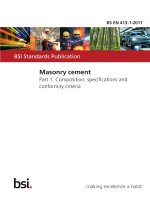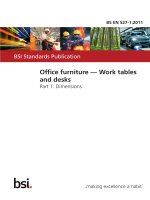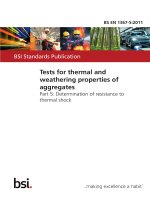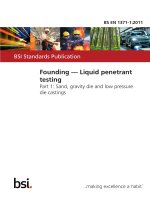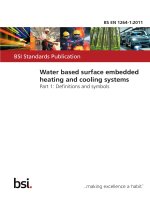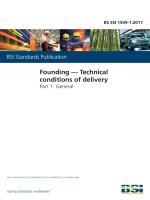Bsi bs en 62386 209 2011
Bạn đang xem bản rút gọn của tài liệu. Xem và tải ngay bản đầy đủ của tài liệu tại đây (2.4 MB, 206 trang )
BS EN 62386-209:2011
BSI Standards Publication
Digital addressable
lighting interface
Part 209: Particular requirements
for control gear — Colour control
(device type 8)
NO COPYING WITHOUT BSI PERMISSION EXCEPT AS PERMITTED BY COPYRIGHT LAW
raising standards worldwide™
BS EN 62386-209:2011 BRITISH STANDARD
National foreword
This British Standard is the UK implementation of EN 62386-209:2011. It is
identical to IEC 62386-209:2011.
The UK participation in its preparation was entrusted by Technical Com-
mittee CPL/34, Lamps and Related Equipment, to Subcommittee CPL/34/3,
Auxiliaries for lamps.
A list of organizations represented on this committee can be obtained on
request to its secretary.
This publication does not purport to include all the necessary provisions of a
contract. Users are responsible for its correct application.
© BSI 2011
ISBN 978 0 580 62957 0
ICS 29.140.50; 29.140.99
Compliance with a British Standard cannot confer immunity from
legal obligations.
This British Standard was published under the authority of the Standards
Policy and Strategy Committee on 31 August 2011.
Amendments issued since publication
Amd. No. Date Text affected
EUROPEAN STANDARD BS EN 62386-209:2011
NORME EUROPÉENNE
EUROPÄISCHE NORM EN 62386-209
ICS 29.140.50; 29.140.99 August 2011
English version
Digital addressable lighting interface -
Part 209: Particular requirements for control gear -
Colour control (device type 8)
(IEC 62386-209:2011)
Interface d'éclairage adressable Digital adressierbare Schnittstelle für die
numérique - Beleuchtung -
Partie 209: Exigences particulières pour Teil 209: Besondere Anforderungen an
les appareillages de commande - Betriebsgeräte -
Commande de la couleur (Type de Farbsteuerung (Gerätetyp 8)
dispositif 8) (IEC 62386-209:2011)
(CEI 62386-209:2011)
This European Standard was approved by CENELEC on 2011-07-29. CENELEC members are bound to comply
with the CEN/CENELEC Internal Regulations which stipulate the conditions for giving this European Standard
the status of a national standard without any alteration.
Up-to-date lists and bibliographical references concerning such national standards may be obtained on
application to the Central Secretariat or to any CENELEC member.
This European Standard exists in three official versions (English, French, German). A version in any other
language made by translation under the responsibility of a CENELEC member into its own language and notified
to the Central Secretariat has the same status as the official versions.
CENELEC members are the national electrotechnical committees of Austria, Belgium, Bulgaria, Croatia, Cyprus,
the Czech Republic, Denmark, Estonia, Finland, France, Germany, Greece, Hungary, Iceland, Ireland, Italy,
Latvia, Lithuania, Luxembourg, Malta, the Netherlands, Norway, Poland, Portugal, Romania, Slovakia, Slovenia,
Spain, Sweden, Switzerland and the United Kingdom.
CENELEC
European Committee for Electrotechnical Standardization
Comité Européen de Normalisation Electrotechnique
Europäisches Komitee für Elektrotechnische Normung
Management Centre: Avenue Marnix 17, B - 1000 Brussels
© 2011 CENELEC - All rights of exploitation in any form and by any means reserved worldwide for CENELEC members.
Ref. No. EN 62386-209:2011 E
BS EN 62386-209:2011
EN 62386-209:2011 - 2 -
Foreword
The text of document 34C/964/FDIS, future edition 1 of IEC 62386-209, prepared by SC 34C, Auxiliaries
for lamps, of IEC TC 34, Lamps and related equipment, was submitted to the IEC-CENELEC parallel vote
and was approved by CENELEC as EN 62386-209 on 2011-07-29.
Attention is drawn to the possibility that some of the elements of this document may be the subject of
patent rights. CEN and CENELEC shall not be held responsible for identifying any or all such patent
rights.
The following dates were fixed:
– latest date by which the EN has to be implemented (dop) 2012-04-29
at national level by publication of an identical
national standard or by endorsement
– latest date by which the national standards conflicting (dow) 2014-07-29
with the EN have to be withdrawn
Annex ZA has been added by CENELEC.
__________
Endorsement notice
The text of the International Standard IEC 62386-209:2011 was approved by CENELEC as a European
Standard without any modification.
In the official version, for Bibliography, the following notes have to be added for the standards indicated:
[1] IEC 60598-1 NOTE Harmonized as EN 60598-1.
[2] IEC 60669-2-1 NOTE Harmonized as EN 60669-2-1.
[3] IEC 60921 NOTE Harmonized as EN 60921.
[4] IEC 60923 NOTE Harmonized as EN 60923.
[5] IEC 60929 NOTE Harmonized as EN 60929.
[6] IEC 61347-1 NOTE Harmonized as EN 61347-1.
[7] IEC 61347-2-3 NOTE Harmonized as EN 61347-2-3.
[8] IEC 61547 NOTE Harmonized as EN 61547.
[9] IEC 62384 NOTE Harmonized as EN 62384.
[10] CISPR 15 NOTE Harmonized as EN 55015.
__________
BS EN 62386-209:2011
- 3 - EN 62386-209:2011
Annex ZA
(normative)
Normative references to international publications
with their corresponding European publications
The following referenced documents are indispensable for the application of this document. For dated
references, only the edition cited applies. For undated references, the latest edition of the referenced
document (including any amendments) applies.
NOTE When an international publication has been modified by common modifications, indicated by (mod), the relevant EN/HD
applies.
Publication Year Title EN/HD Year
IEC 62386-101 2009 2009
IEC 62386-102 2009 Digital addressable lighting interface - EN 62386-101 2009
CIE 1931 Part 101: General requirements - System -
CIE 17.4 1987 -
Digital addressable lighting interface - EN 62386-102
Part 102: General requirements - Control gear
Commission internationale de l'Eclairage - -
Proceedings
International Lighting Vocabulary -
BS EN 62386-209:2011
– 2 – 62386-209 © IEC:2011
CONTENTS
INTRODUCTION................................................................................................................... 10
1 Scope............................................................................................................................. 11
2 Normative references ..................................................................................................... 11
3 Terms and definitions ..................................................................................................... 11
4 General .......................................................................................................................... 13
4.4 Colour type............................................................................................................ 13
4.4.1 General ..................................................................................................... 13
4.4.2 Colour type: xy-coordinate ......................................................................... 14
4.4.3 Colour type: colour temperature Tc............................................................ 14
4.4.4 Colour type: primary N............................................................................... 15
4.4.5 Colour type: RGBWAF ............................................................................... 15
5 Electrical specification .................................................................................................... 16
6 Interface power supply ................................................................................................... 16
7 Transmission protocol Structure ..................................................................................... 16
8 Timing ............................................................................................................................ 16
9 Method of operation ....................................................................................................... 16
9.1 Logarithmic dimming curve, arc power levels and accuracy ...................................16
9.1.1 Colour light output versus arc power level ................................................. 16
9.2 9.1.2 Direct arc power level ................................................................................ 16
9.1.3 Indirect arc power levels ............................................................................ 17
9.3 Power on ............................................................................................................... 18
9.2.1 General ..................................................................................................... 18
9.4 9.2.2 Store power on colour ............................................................................... 18
9.5 9.2.3 Query power on colour .............................................................................. 18
9.6 Interface-failure ..................................................................................................... 19
9.9 9.3.1 General ..................................................................................................... 19
9.10 9.3.2 Store system failure colour ........................................................................ 19
9.11 9.3.3 Query system failure colour ....................................................................... 19
Min and max level ................................................................................................. 20
9.12 Fade time and fade rate ........................................................................................ 20
Reaction to commands during error state .............................................................. 20
16 Bit data transfer for the application extended control commands ......................20
Multi colour type control gear ................................................................................ 20
Colour scenes ....................................................................................................... 21
9.11.1 General ..................................................................................................... 21
9.11.2 Store colour scene XXXX .......................................................................... 21
9.11.3 Remove colour scene XXXX ...................................................................... 21
9.11.4 Go to colour scene XXXX .......................................................................... 21
9.11.5 Query colour scene XXXX ......................................................................... 22
Colour change ....................................................................................................... 22
9.12.1 Colour type xy-coordinate .......................................................................... 22
9.12.2 Colour type colour temperature Tc............................................................. 22
9.12.3 Colour type change ................................................................................... 22
9.12.4 Temporary colour setting ........................................................................... 22
BS EN 62386-209:2011
62386-209 © IEC:2011 – 3 –
9.12.5 Activate colour settings ............................................................................. 23
9.12.6 Reporting colour settings ........................................................................... 26
9.12.7 Copy from report to temporary variables .................................................... 26
9.13 Colour temperature Tc limits ................................................................................. 26
10 Declaration of variables .................................................................................................. 27
11 Definition of commands .................................................................................................. 30
11.1 Arc power control commands................................................................................. 30
11.1.1 Direct arc power control command............................................................. 30
11.1.2 Indirect arc power control commands ........................................................ 30
11.2 Configuration commands ....................................................................................... 31
11.2.1 General configuration commands .............................................................. 31
11.2.2 Arc power parameters settings .................................................................. 31
11.2.3 System parameters settings ...................................................................... 32
11.3 Query commands .................................................................................................. 32
11.3.1 Queries related to status information ......................................................... 32
11.3.2 Queries related to arc power parameters settings ...................................... 32
11.3.3 Queries related to system parameter settings ............................................ 33
11.3.4 Application extended commands ............................................................... 33
11.4 Special commands ................................................................................................ 42
11.4.4 Extended special commands ..................................................................... 42
11.5 Summary of the command set ............................................................................... 42
11.5.1 Summary of the extended application command set ..................................42
11.5.2 Command versus colour type cross-reference ........................................... 43
11.5.3 Command versus the DTR, DTR1 and DTR2 cross-reference table ...........44
12 Test procedures ............................................................................................................. 46
12.2 Test sequences 'Configuration commands' ............................................................ 46
12.2.1 Test sequences 'General configuration commands'....................................46
12.7 Test sequences 'Application extended commands for device type 8'...................... 66
12.7.1 Test sequences 'APPLICATION EXTENDED QUERY COMMANDS' ..........66
12.7.2 Test sequences 'Application extended configuration commands' ...............83
12.7.3 Test sequence 'ENABLE DEVICE TYPE' ................................................. 157
12.7.4 Test sequences “Application extended control commands” ...................... 160
12.7.5 Test sequences 'Standard application extended commands' .................... 195
13 General subsequences ................................................................................................. 197
13.1 Test sequence “Set16bitValue (val)”.................................................................... 197
13.2 Test sequence “SetSpecific16bitValue (val)” ....................................................... 198
13.3 Test sequence “Get16bitValue ( )” ....................................................................... 199
13.4 Test sequence “Get16bitColourValue ( )”............................................................. 200
Bibliography........................................................................................................................ 201
Figure 1 – The CIE color space chromaticity diagram, 1931 Cambridge University
Press .................................................................................................................................... 14
Figure 2 – Black body line..................................................................................................... 15
Figure 3 – Colour temperature diagram ................................................................................. 15
Figure 4 – Application extended configuration command sequence example.........................36
Figure 5 – Test sequence “RESET”....................................................................................... 47
Figure 6 – Test sequence “testResetDefault (Colour Type)” .................................................. 48
Figure 7 – Test sequence “testReset_xy” .............................................................................. 50
BS EN 62386-209:2011
– 4 – 62386-209 © IEC:2011
Figure 8 – Test sequence “testReset_Tc”.............................................................................. 52
Figure 9 – Test sequence “testReset_PrimaryN” ................................................................... 54
Figure 10 – Test sequence “testReset_RGBWAF”................................................................. 56
Figure 11 – Test sequence “testResetNoChange_xy”............................................................ 57
Figure 12 – Test sequence “testResetNoChange_Tc” ........................................................... 59
Figure 13 – Test sequence “testResetNoChange_PrimaryN” ................................................. 61
Figure 14 – Test sequence “testResetNoChange_RGBWAF” ................................................ 62
Figure 15 – Test sequence “testResetIndependentColourType” ............................................ 63
Figure 16 – Test sequence “Save_PrimaryN” ........................................................................ 64
Figure 17 – Test sequence “Restore_PrimaryN (xPrimary, yprimary, TYPrimary” .................. 65
Figure 18 – Test sequence “QUERY GEAR FEATURES/STATUS” ........................................ 66
Figure 19 – Test sequence “QUERY COLOUR STATUS” ...................................................... 68
Figure 20 – Test sequence “ActivateAndCheck (ColourType, curActive)” .............................. 69
Figure 21 – Test sequence “xyOutOfRangeCheck( )” ............................................................ 71
Figure 22 – Test sequence “TcOutOfRangeCheck” ............................................................... 72
Figure 23 – Test sequence “CheckOnlyOneColourTypeActive” ............................................. 73
Figure 24 – Test sequence “TcOutOfRangePhysWarmest”.................................................... 74
Figure 25 – Test sequence “TcOutOfRangeCheckPhysCoolest” ............................................ 75
Figure 26 – Test sequence 'QUERY COLOUR TYPE FEATURES' ........................................76
Figure 27 – Test sequence 'QUERY COLOUR VALUE' ......................................................... 79
Figure 28 – Test sequence “QUERY RGBWAF CONTROL”................................................... 81
Figure 29 – test sequence “QUERY ASSIGNED COLOUR” ................................................... 82
Figure 30 – Test sequence “STORE TY PRIMARY N” ........................................................... 84
Figure 31 – Test sequence “CheckDTR2Behaviour8(nrPrim)” ............................................... 85
Figure 32 – Test sequence “STORE xy-COORDINATE PRIMARY N” .................................... 87
Figure 33 – Test sequence “CheckDTR2Behaviour_XY(nrPrim)” ........................................... 89
Figure 34 – Test sequence “STORE COLOUR TEMPERATURE Tc LIMIT”............................ 90
Figure 35 – Test sequence “TcCheckDTR2Behaviour( )”.......................................................91
Figure 36 – Test sequence “TcSavePhysicalLimits” .............................................................. 92
Figure 37 – Test sequence “TcRestorePhysicalLimits(phLimits) ............................................ 93
Figure 38 – Test sequence “TcCheckLimits” ......................................................................... 95
Figure 39 – Test sequence “STORE GEAR FEATURES/STATUS” ........................................ 96
Figure 40 – Test sequence “AUTOMATIC ACTIVATE” .......................................................... 97
Figure 41 – Test sequence “AutoActivate_xy (min_level, command, delay,
expected_level)” ................................................................................................................... 98
Figure 42 – Test sequence “NoAutoActivate_xy (min_level, command, delay,
expected_level)” ................................................................................................................... 99
Figure 43 – Test sequence “AutoActivate_Tc (min_level, command, delay,
expected_level)” ................................................................................................................. 100
Figure 44 – Test sequence “NoAutoActivate_Tc (min_level, command, delay,
expected_level)” ................................................................................................................. 101
Figure 45 – Test sequence “AutoActivate_PrimaryN (min_level, command, delay,
expected_level)” ................................................................................................................. 102
Figure 46 – Test sequence “NoAutoActivate_PrimaryN (min_level, command, delay,
expected_level)” ................................................................................................................. 103
BS EN 62386-209:2011
62386-209 © IEC:2011 – 5 –
Figure 47 – Test sequence “AutoActivate_RGBWAF (min_level, command, delay,
expected_level)” ................................................................................................................. 104
Figure 48 – Test sequence “NoAutoActivate_RGBWAF (min_level, command, delay,
expected_level)” ................................................................................................................. 105
Figure 49 – Test sequence “AutoActivate_Dapc0”............................................................... 106
Figure 50 – Test sequence “AutoActivate_Off” .................................................................... 107
Figure 51 – Test sequence “Load_xy_Coordinate (point_x, point_y)” .................................. 108
Figure 52 – Test sequence “Get_actual_xy ( )” ................................................................... 109
Figure 53 – Test sequence “findTwoValid_Tc_Points ( )” .................................................... 110
Figure 54 – Test sequence “Load_Tc (Tc_value)” ............................................................... 111
Figure 55 – Test sequence “Get_actual_Tc ( )” ................................................................... 112
Figure 56 – Test sequence “findTwoValid_PrimaryN_Points ( )” .......................................... 113
Figure 57 – Test sequence “Load_PrimaryN(point_PrimaryN)” ............................................ 114
Figure 58 – Test sequence “Get_actual_PrimaryN ( )”......................................................... 115
Figure 59 – Test sequence “findTwoValid_RGBWAF_Pionts ( )” ......................................... 116
Figure 60 – Test sequence “Load_RGBWAF(point_RGBWAF)” ........................................... 117
Figure 61 – Test sequence “Get_actual_RGBWAF ( )” ........................................................ 118
Figure 62 – Test sequence “ToggleAutoActivation(auto)” .................................................... 119
Figure 63 – Test sequence “ASSIGN COLOUR TO LINKED CHANNEL” ............................. 120
Figure 64 – Test sequence “START AUTO CALIBRATION”................................................. 122
Figure 65 – Test sequence “POWER ON COLOUR”............................................................ 123
Figure 66 – Test sequence “PowerOnBehaviour_xy” ........................................................... 125
Figure 67 – Test sequence “PowerOnBehaviour_Tc” .......................................................... 127
Figure 68 – Test sequence “PowerOnBehaviour_PrimaryN” ................................................ 129
Figure 69 – Test sequence “PowerOnBehaviour_RGBWAF” ............................................... 131
Figure 70 – Test sequence “PowerOnBehaviourMask_xy”................................................... 132
Figure 71 – Test sequence “PowerOnBehaviourMask_Tc” .................................................. 133
Figure 72 – Test sequence “PowerOnBehaviourMask_PrimaryN” ........................................ 135
Figure 73 – Test sequence “PowerOnBehaviourMask_RGBWAF” ....................................... 137
Figure 74 – Test sequence “SYSTEM FAILURE”................................................................. 139
Figure 75 – Test sequence “SystemFailureBehaviour_xy” ................................................... 141
Figure 76 – Test sequence “SystemFailureBehaviour_Tc”................................................... 143
Figure 77 – Test sequence “SystemFailureBehaviourPrimaryN” .......................................... 145
Figure 78 – Test sequence “SystemFailureBehaviour_RGBWAF”........................................ 147
Figure 79 – Test sequence “SystemFailureBehaviourMask_xy” ........................................... 148
Figure 80 – Test sequence “SystemFailureBehaviourMask_Tc” .......................................... 149
Figure 81 – Test sequence “SystemFailureBehaviourMask_PrimaryN” ................................ 151
Figure 82 – Test sequence “SystemFailureBehaviourMask_RGBWAF” ............................... 153
Figure 83 – Test sequence “STORE THE DTR AS SCENE XXXX/ GOTO SCENE
XXXX”................................................................................................................................. 155
Figure 84 – Test sequence “SetTemporaries (col, val)” ....................................................... 156
Figure 85 – Test sequence “ENABLE DEVICE TYPE: Application extended commands” ..... 158
Figure 86 – Test sequence “ENABLE DEVICE TYPE: Application extended
configuration commands” .................................................................................................... 159
BS EN 62386-209:2011
– 6 – 62386-209 © IEC:2011
Figure 87 – Test sequence “SET TEMPORARY x-COORDINATE” ...................................... 160
Figure 88 – Test sequence “SET TEMPORARY y-COORDINATE” ...................................... 161
Figure 89 – Test sequence “ACTIVATE” ............................................................................. 162
Figure 90 – Test sequence “FindTwoValid_xy_Points (point1_x, point1_y, point2_x,
point2_y)” ........................................................................................................................... 163
Figure 91 – Test sequence “Goto_xy_Coordinate (Point_x, point_y)” .................................. 164
Figure 92 – Test sequence “x-COORDINATE STEP UP” ..................................................... 165
Figure 93 – Test sequence “ActivateColourType (Colour Type)” ......................................... 166
Figure 94 – Test sequence “x-COORDINATE STEP DOWN” ............................................... 167
Figure 95 – Test sequence “Get MainPointxy ( )” ................................................................ 168
Figure 96 – Test sequence “GetCurrentPointxy ( )” ............................................................. 169
Figure 97 – Test sequence “xymodeGetMainPointxy ( )” ..................................................... 170
Figure 98 – Test sequence “SET TEMPORARY COLOUR TEMPERATURE Tc” .................. 171
Figure 99 – Test sequence “FindValidTcValue (TcValue)” ................................................... 172
Figure 100 – Test sequence “CheckAllTcValues ( )”............................................................ 173
Figure 101 – Test sequence “COLOUR TEMPERATURE Tc STEP COOLER” ..................... 174
Figure 102 – Test sequence “COLOUR TEMPERATURE Tc STEP WARMER” .................... 175
Figure 103 – Test sequence “SET TEMPORARY PRIMARY N DIMLEVEL” ......................... 176
Figure 104 – Test sequence “CheckPrimaryNFadingBehaviour (nPrim)” ............................. 177
Figure 105 – Test sequence “SET TEMPORARY RGB DIMLEVEL” ..................................... 178
Figure 106 – Test sequence “CheckRGBFadingBehaviour ( )” ............................................ 179
Figure 107 – Test sequence “SET TEMPORARY WAF DIMLEVEL ...................................... 180
Figure 108 – Test sequence “CheckWAFFadingBehaviour ( )” ............................................ 181
Figure 109 – Test sequence “SET RGBWAF CONTROL” .................................................... 182
Figure 110 – Test sequence “Chan_Col_Control_ActivationTest (nrChan)” ......................... 183
Figure 111 – “Norm_Col_Control_ActivationTest ( )” ........................................................... 184
Figure 112 – Test sequence “Transition_To_Inactive_Test ( )” ............................................ 185
Figure 113 – Test sequence “COPY REPORT TO TEMPORARY” ....................................... 186
Figure 114 – Test sequence “Copy_xy ( )” .......................................................................... 187
Figure 115 – Test sequence “Copy_Tc ( )” .......................................................................... 188
Figure 116 – Test sequence “Copy_PrimaryN ( )” ............................................................... 189
Figure 117 – Test sequence “Copy_RGBWAF ( )” ............................................................... 190
Figure 118 – Test sequence “PrimaryN_Check1 (nrPrim)”................................................... 191
Figure 119 – Test sequence “PrimaryN_Check2 (nrPrim)”................................................... 192
Figure 120 – Test sequence “RGBWAF_Check1 (nrChan)” ................................................. 193
Figure 121 – Test sequence “RGBWAF_Check2 (nrChan)” ................................................. 194
Figure 122 – Test sequence “QUERY EXTENDED VERSION NUMBER”............................. 195
Figure 123 – Test sequence “RESERVED APPLICATION EXTENDED COMMANDS” ......... 196
Figure 124 – “Set16bitValue (val)” ...................................................................................... 197
Figure 125 – Test sequence “SetSpecific16bitValue (val)” .................................................. 198
Figure 126 – Test sequence “Get16bitValue ( )”.................................................................. 199
Figure 127 – Test sequence “Get16bitColourValue ( )”........................................................ 200
BS EN 62386-209:2011
62386-209 © IEC:2011 – 7 –
Table 1 – Power on............................................................................................................... 18
Table 2 – Interface failure ..................................................................................................... 19
Table 3 – Min and Max level ................................................................................................. 20
Table 4 – Colour scenes ....................................................................................................... 21
Table 5 – System reaction on DAPC and TEMPORARY COLOUR TYPE .............................. 24
Table 6 – System reaction on commands and colour type ..................................................... 24
Table 7 – Tc limit change behaviour ...................................................................................... 27
Table 8 – Declaration of variables......................................................................................... 28
Table 9 – Store colour temperature Tc limit ........................................................................... 37
Table 10 – Assign channel to colour ..................................................................................... 37
Table 11 – Query colour value .............................................................................................. 39
Table 12 – Query assigned colour......................................................................................... 42
Table 13 – Summary of the extended application command set ............................................ 42
Table 14 – Command versus colour type cross-reference ..................................................... 44
Table 15 – Command versus the DTR, DTR1 and DTR2 cross-reference..............................45
Table 16 – Command returns to test sequence “QUERY COLOUR VALUE” ..........................77
BS EN 62386-209:2011
– 10 – 62386-209 © IEC:2011
INTRODUCTION
This first edition of IEC 62386-209 is published in conjunction with IEC 62386-101 and
IEC 62386-102. The division of IEC 62386 into separately published parts provides for ease
of future amendments and revisions. Additional requirements will be added as and when a
need for them is recognised.
This International Standard, and the other parts that make up the IEC 62386-200 series, in
referring to any of the clauses of IEC 62386-101 or IEC 62386-102, specifies the extent to
which such a clause is applicable and the order in which the tests are to be performed. The
parts also include additional requirements, as necessary. All parts that make up the
IEC 62386-200 series are self-contained and therefore do not include references to each
other.
Where the requirements of any of the clauses of IEC 62386-101 or IEC 62386-102 are
referred to in this International Standard by the sentence "The requirements of
IEC 62386-1XX, clause ‘n’ apply”, this sentence is to be interpreted as meaning that all
requirements of the clause in question of Part 101 or Part 102 apply, except any which are
inapplicable to the specific type of lamp control gear covered by Part 209.
All numbers used in this International Standard are decimal numbers unless otherwise noted.
Hexadecimal numbers are given in the format 0xVV, where VV is the value. Binary numbers
are given in the format XXXXXXXXb or in the format XXXX XXXX, where X is 0 or 1; 'x' in
binary numbers means 'don't care'.
BS EN 62386-209:2011
62386-209 © IEC:2011 – 11 –
DIGITAL ADDRESSABLE LIGHTING INTERFACE –
Part 209: Particular requirements for control gear –
Colour control (device type 8)
1 Scope
This International Standard specifies a protocol and test procedures for the control by digital
signals of electronic control gear that can change their light colour.
NOTE Tests in this standard are type tests. Requirements for testing individual control gear during production are
not included.
2 Normative references
The following referenced documents are indispensable for the application of this document.
For dated references, only the edition cited applies. For undated references, the latest edition
of the referenced document (including any amendments) applies.
IEC 62386-101:2009, Digital addressable lighting interface – Part 101: General requirements
– System
IEC 62386-102:2009, Digital addressable lighting interface – Part 102: General requirements
– Control gear
CIE (1932), Commission internationale de l'Eclairage proceedings, 1931. Cambridge
University Press, Cambridge.
CIE 17-4:1987, International lighting vocabulary, ISBN 978 3 900734 07 7
3 Terms and definitions
For the purposes of this document, the terms and definitions given in Clause 3 of
IEC 62386-101:2009 and Clause 3 of IEC 62386-102:2009 apply, with the following additional
definitions.
3.1
colour type
mechanism to set a colour in an appropriate way
3.2
xy chromaticity
colour type, representing the colour matching functions of a standard observer according to
the Commission Internationale de L’Eclairage (CIE) basis for colorimetry of 1931
3.3
colour temperature
Tc
colour type, representing the colour of a light source that matches the temperature of a
black body radiator according to Planck’s law
BS EN 62386-209:2011
– 12 – 62386-209 © IEC:2011
3.4
correlated colour temperature
CCT
colour temperature of the Planckian radiator whose perceived colour most closely resembles
that of the given stimulus at the same brightness and under specified viewing conditions (from
CIE 17-4:1987)
3.5
primary N
colour type, representing a single output channel of the gear
3.6
RGBWAF
colour type, in which the output channels of the control gear can be associated with red (R),
green (G), blue (B), white (W), amber (A) or freecolour (F)
3.7
RGBWAF dimlevel
term that specifies the set of red dimlevel, green dimlevel, blue dimlevel, white dimlevel,
amber dimlevel and freecolour dimlevel
3.8
colour value
number or a set of numbers interpreted in the context of a colour type to specify a colour
3.9
TY
number that represents the brightness or luminance of a colour in the xy colour space
NOTE x and y are the chromaticity coordinates calculated from the tristimulus values XYZ. TY is identical to the
tristimulus value Y
3.10
colour setting
combination of colour type and colour value
3.11
total output light intensity
visible optical output of the control gear depending on its arc power level and colour
3.12
control type
processing method of arc power control commands for colour type RGBWAF
3.13
colour space
plane scaled in such a way that any colour within it may be identified with two coordinates x
and y, where x and y are both in the range 0 to 1
3.14
attainable colour space
part of the colour space that a control gear / lamp combination is able to render
3.15
temporary colour setting
combination of temporary colour type and temporary colour value, used for control gear
internal processing only
NOTE The temporary colour setting has no visible effect on light output
BS EN 62386-209:2011
62386-209 © IEC:2011 – 13 –
3.16
temporary colour type
a mechanism to set a colour in an appropriate way, used for control gear internal processing
only
NOTE The temporary colour type has no visible effect on light output
3.17
temporary colour value
number or a set of numbers interpreted in the context of a temporary colour type to specify a
colour, used for control gear internal processing only
NOTE The temporary colour value has no visible effect on light output
3.18
report colour setting
combination of report colour type and report colour value, only used for querying control gear
status
NOTE The report colour setting has no visible effect on light output
3.19
report colour type
colour type only used for querying a stored or the actual colour type
NOTE The report colour type has no visible effect on light output
3.20
report colour value
number or a set of numbers interpreted in the context of a report colour type to specify a
colour
NOTE The report colour value has no visible effect on light output
3.21
colour transition
change from a colour setting to another in a specified time
3.22
temporary RGBWAF dimlevel
shorthand for temporary R dimlevel, temporary G dimlevel, temporary B dimlevel, temporary
W dimlevel, temporary A dimlevel and temporary F dimlevel
4 General
The requirements of Clause 4 of IEC 62386-101:2009 and of Clause 4 of IEC 62386-102:2009
shall apply with the following exception.
Additional subclauses:
4.4 Colour type
4.4.1 General
There are four colour types of which only one colour type shall be active at any moment.
If the control gear supports a colour type all commands related to that colour type (see
Table 14) shall be implemented. Some of the application extended commands (see 11.3.4)
are applicable to only one colour type, whereas others have a more general character. If an
BS EN 62386-209:2011
– 14 – 62386-209 © IEC:2011
application extended command is relevant or has relevant parts for a supported colour type,
these parts shall be implemented.
4.4.2 Colour type: xy-coordinate
The output colour shall correspond as closely as possible to that shown in Figure 1 for the
point in the colour space defined by the x and y co-ordinates. The total output light intensity
shall depend on the requested x and y coordinates and the arc power level.
If the control gear has exchangeable light source(s) and does not support automatic
calibration then the control gear shall also support colour type primary N.
Figure 1 – The CIE color space chromaticity diagram, 1931 Cambridge University Press
4.4.3 Colour type: colour temperature Tc
A black body (perfect radiant body) changes its colour from red through yellow to white as its
temperature increases (black body line – BBL). The absolute temperature T (Kelvin) of the
black body is referred to as the colour temperature TC (see Figure 1).
The total output light intensity shall depend on the requested colour temperature TC and the
arc power level.
Many light sources do not emit a light colour caused by the temperature of the light source
itself, e.g. LED or fluorescent lamp versus tungsten lamp, and do not exactly follow the black
body line. The colour emitted from the light source that is perceived by the human eye and
BS EN 62386-209:2011
62386-209 © IEC:2011 – 15 –
that matches closest to the black body line is called correlated colour temperature, see 3.4.
The correlated colour temperature of the light output shall be as close as possible to the
requested colour temperature.
Figure 2 – Black body line
Mirek is the unit used to express the colour temperature TC (see Figure 3). Mirek is equivalent
to one million times the reciprocal value of the colour temperature T in Kelvin:
Mirek = 1000 000
T
20000K 1000K
50Mirek 1000Mirek
Figure 3 – Colour temperature diagram
4.4.4 Colour type: primary N
Primary N gives direct control over the light intensity of each available output channel.
4.4.5 Colour type: RGBWAF
RGBWAF comprises a method where at least 1 output channel and maximum 6 output
channels, each connected with a lamp of e.g. a different colour, can be controlled
independently via arc power level.
An output channel shall be assigned to the dedicated colour R (red), G (green), B (blue),
W (white), A (amber) or F (freecolour). Multiple channels can be assigned to the same or
different colours. Output channels are assigned by default to a particular colour but can be
reassigned to the colours red, green, blue, white, amber or freecolour.
Channels can be linked or unlinked, see 9.1 for more details.
Direct and indirect arc power control commands can be processed by means of the following
control types:
– channel control (arc power control commands are processed to linked output channels);
BS EN 62386-209:2011
– 16 – 62386-209 © IEC:2011
– colour control (arc power control commands are processed to output channels assigned to
linked colours);
– normalised colour control (arc power control commands are used for intensity control,
whereas the colour stays constant).
NOTE Only “Normalised colour control” RGBWAF can be used to achieve a constant colour output.
5 Electrical specification
The requirements of Clause 5 of IEC 62386-101:2009 and Clause 5 of IEC 62386-102:2009
shall apply.
6 Interface power supply
The requirements of Clause 6 of IEC 62386-101:2009 and Clause 6 of IEC 62386-102:2009
shall apply, if a power supply is integrated with the control gear.
7 Transmission protocol Structure
The requirements of Clause 7 of IEC 62386-101:2009 and Clause 7 of IEC 62386-102:2009
shall apply.
8 Timing
The requirements of Clause 8 of IEC 62386-101:2009 and Clause 8 of IEC 62386-102:2009
shall apply.
9 Method of operation
The requirements of Clause 9 of IEC 62386-101:2009 and Clause 9 of IEC 62386-102:2009
shall apply, except as follows:
9.1 Logarithmic dimming curve, arc power levels and accuracy
Addition:
9.1.1 Colour light output versus arc power level
The colour output can change automatically on most commands that affect the arc power
level. Alternatively the colour change can be triggered using the “ACTIVATE” command. The
automatic activation bit determines whether activation is automatic or explicit. The concept is
explained further in this clause. See Table 5 and Table 6 for an overview of the system
reaction to a change in arc power level and the relation to colour.
9.1.2 Direct arc power level
The light output depends on the colour type being used and the value given by the arc power
level.
A “DIRECT ARC POWER CONTROL” command with a value of 255 (“MASK”) shall ‘STOP
FADING’ for all colour types.
A “DIRECT ARC POWER CONTROL” command with a value of 0 shall turn off the light for all
colour types.
BS EN 62386-209:2011
62386-209 © IEC:2011 – 17 –
A “DIRECT ARC POWER CONTROL” command with a value of 1-254 shall turn on the light
and the light output created by the 4 colour types shall further be affected by arc power level
as follows:
− xy-coordinate: The arc power level controls the intensity of the light output.
− TC: The arc power level controls the intensity of the light output.
− primary N: The intensity of the light output is independent of the arc power level.
− RGBWAF shall first update the RGBWAF control type based on the TEMPORARY
RGBWAF CONTROL byte, then depending on the resulting RGBWAF control type:
• control type ‘Channel control’ and ‘Colour control’
– linked channels/colours: The requirements of Clause 9.1 of IEC 62386-102 apply.
The linked channels shall not react to RGBWAF dimlevels.
– unlinked channels/colours: The light output is independent of the arc power level.
The unlinked channels shall react to RGBWAF dimlevels.
• control type ‘Normalised colour control’
– linked colours: The requirements of Clause 9.1 of IEC 62386-102 apply. The linked
colours shall not react to RGBWAF dimlevels.
– unlinked colours: The light output shall be scaled according to the following
formula:
R
G
B • ArcPowerLevel
CR W MAX ( R,G, B,W , A, F ) when MAX ( R,G, B,W , A, F ) ≠ 0
when MAX ( R,G, B,W , A, F ) = 0
CG A
CB
F
=
CW 1
C A 1
C 1
F 1 • ArcPowerLevel
1
1
NOTE 1 MAX (R,G,B,W,A,F) is the maximum value of the RGBWAF Dimlevel.
NOTE 2 CX is the value processed to the output channel(s) assigned to the colour X.
NOTE 3 R,G,B,W,A,F represent a dimlevel
9.1.3 Indirect arc power levels
For indirect arc power levels the control gear shall react as with the direct arc power level
command, except that a level of 255 (“MASK”) shall now mean “DON’T CHANGE”.
BS EN 62386-209:2011
– 18 – 62386-209 © IEC:2011
9.2 Power on
9.2.1 General
A control gear shall react according to Clause 9.2 of IEC 62386-102 with the following
additions:
The power on colour setting shall be used as described below. In addition, if the “POWER ON
LEVEL” is triggered, the power on colour setting shall be activated (see 9.12.5).
When the “POWER ON COLOUR VALUES” are “MASK”, the colour setting of the power on
level shall be the most recent colour.
When not all “POWER ON COLOUR VALUES” are “MASK”, the colour setting for the colour
values that are “MASK” shall be the most recent value, and the colour values that are set
shall change to the requested value.
9.2.2 Store power on colour
The power on colour setting shall be stored on receipt of command 45 (STORE THE DTR AS
POWER ON LEVEL).
The following data shall be stored (see Table 1):
• “POWER ON COLOUR TYPE” (colour type that shall be used);
• “POWER ON COLOUR VALUE” (colour value that shall be used);
• “POWER ON LEVEL” (DTR).
The temporary colour type (see 9.12.4) shall be automatically derived from the last temporary
colour value that has been changed.
“TEMPORARY “POWER ON Table 1 – Power on “POWER ON
COLOUR COLOUR TYPE” LEVEL” (part 102)
TYPE” “POWER ON COLOUR VALUE”
xy-coordinate DTR value (intensity)
xy-coordinate colour temperature “TEMPORARY xy-COORDINATE” DTR value (intensity)
“TEMPORARY COLOUR TEMPERATURE TC”
colour TC DTR value
temperature TC primary N “TEMPORARY PRIMARY N DIMLEVEL” DTR value
RGBWAF “TEMPORARY RGBWAF DIMLEVEL” and
primary N DTR value
“TEMPORARY RGBWAF CONTROL”
RGBWAF No change
255 (“MASK”) No change
NOTE 1 When the “TEMPORARY COLOUR TYPE” is “MASK” the colour setting of the power on level is not
changed.
NOTE 2 To attain the effect that the power on colour setting uses the most recent colour, the “POWER ON
COLOUR VALUES” should be set to “MASK”.
9.2.3 Query power on colour
The colour setting of “SYSTEM FAILURE” shall be copied to the report colour type and the
corresponding report colour values when receiving command 164 (QUERY SYSTEM FAILURE
LEVEL). The “REPORT COLOUR TYPE” and the “REPORT COLOUR VALUE” can be queried
using command 250 (QUERY COLOUR VALUE).
